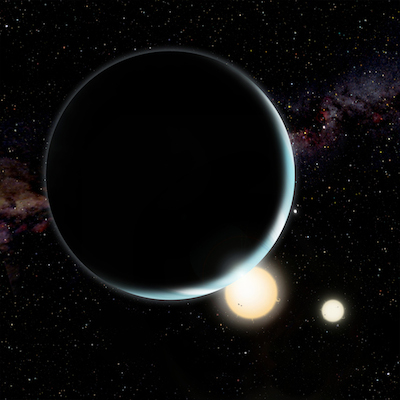Bristol University Researchers Use Computer Simulations To Study Planets That Orbit Two Stars
Aiming at unlocking the mysteries of the universe, researchers from University of Bristol have used computer simulations to study the circumbinary planets. To understand the theory behind this, we need to know why are some planets called circumbinary. Research suggests that due to the close proximity and orbit of some binary stars, planets have to orbit around two stars, instead of one. According to Wikipedia, as of December 5, 2013, there are seventeen confirmed systems of circumbinary planets. In a recent press release, University of Bristol researchers have shared that as observed from the Kepler Space Telescope, it has come to light that the Luke Skywalker's home planet Tatooine would have formed far from its current location in the Star Wars universe.
Circumbinary planets have been a matter of awe for both science fiction book readers and movie buffs. They have been a subject of great interest to movie makers as well as the space geeks among us. The current research only goes to say how remarkable these planets are. The research paper called #-Link-Snipped-# by S. Lines, Z. M. Leinhardt, S. Paardekooper, C. Baruteau and P. Thebault was published in the #-Link-Snipped-#. In the new revelations, it is now being shared that there are few environments more extreme than a binary star system in which planet formation can occur. Grinding down of the material happens due to destructive collisions resulting from powerful gravitational perturbations from these two stars on the rocky building blocks of planets happens. Therefore, it becomes difficult to explain the presence of such circumbinary planets.
 Thanks to the computer simulations created by Bristol's scientists, we can now see the early stages of planet formation around the binary stars using a sophisticated model that calculates the effect of gravity and physical collisions on and between one million planetary building blocks. The results show that most of such planets must've formed much further away from the central binary stars and then migrated to their current location. Dr. Leinhardt shared how their simulations show that the circumbinary disk is a hostile environment even for large, gravitationally strong objects. Taking into account data on collisions as well as the physical growth rate of planets, they have found that Kepler 34(AB)b would have struggled to grow where we find it now.
Thanks to the computer simulations created by Bristol's scientists, we can now see the early stages of planet formation around the binary stars using a sophisticated model that calculates the effect of gravity and physical collisions on and between one million planetary building blocks. The results show that most of such planets must've formed much further away from the central binary stars and then migrated to their current location. Dr. Leinhardt shared how their simulations show that the circumbinary disk is a hostile environment even for large, gravitationally strong objects. Taking into account data on collisions as well as the physical growth rate of planets, they have found that Kepler 34(AB)b would have struggled to grow where we find it now.
The more knowledge there is available about the existence and formation of these extraordinary planets, the more we will be able to understand and assist future exoplanet discovery missions in the hunt for earth-like planets in binary star systems. What are your views about the circumbinary planets? Share with us in comments below.
Source: #-Link-Snipped-#
Circumbinary planets have been a matter of awe for both science fiction book readers and movie buffs. They have been a subject of great interest to movie makers as well as the space geeks among us. The current research only goes to say how remarkable these planets are. The research paper called #-Link-Snipped-# by S. Lines, Z. M. Leinhardt, S. Paardekooper, C. Baruteau and P. Thebault was published in the #-Link-Snipped-#. In the new revelations, it is now being shared that there are few environments more extreme than a binary star system in which planet formation can occur. Grinding down of the material happens due to destructive collisions resulting from powerful gravitational perturbations from these two stars on the rocky building blocks of planets happens. Therefore, it becomes difficult to explain the presence of such circumbinary planets.

The more knowledge there is available about the existence and formation of these extraordinary planets, the more we will be able to understand and assist future exoplanet discovery missions in the hunt for earth-like planets in binary star systems. What are your views about the circumbinary planets? Share with us in comments below.
Source: #-Link-Snipped-#
0
